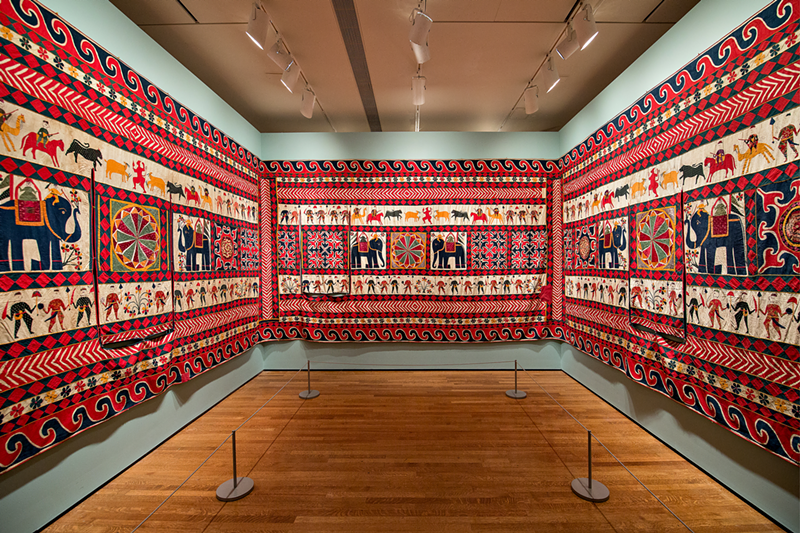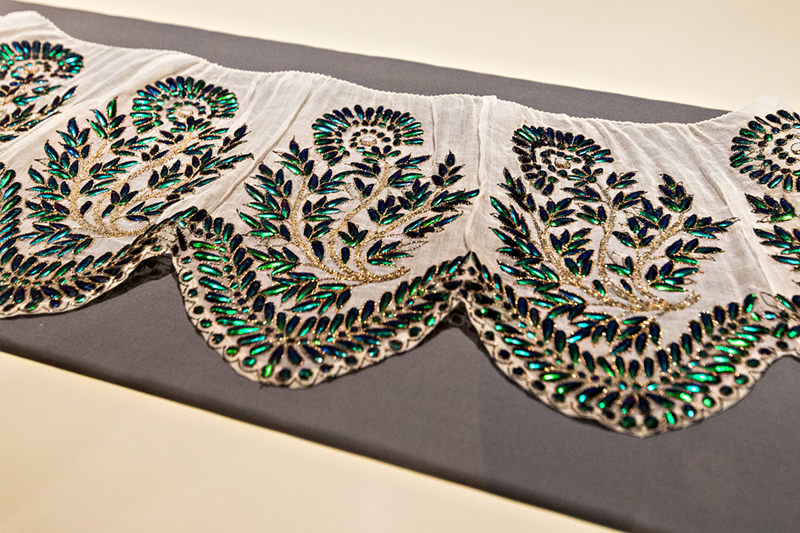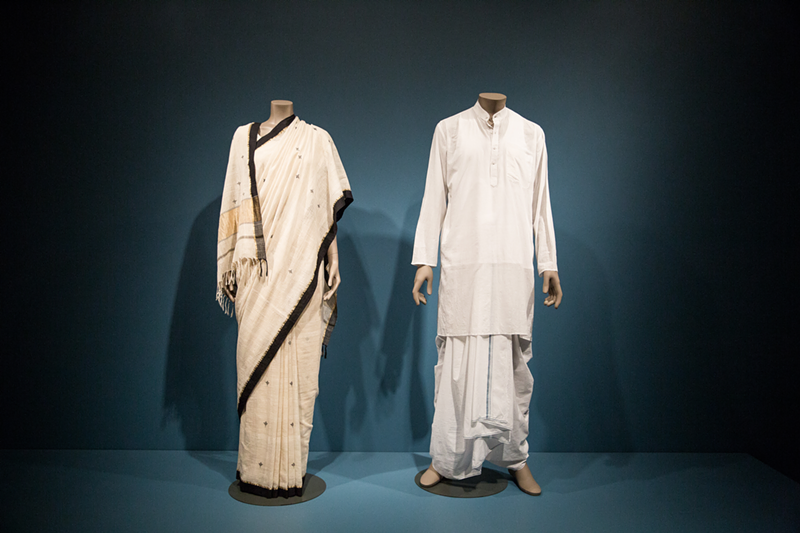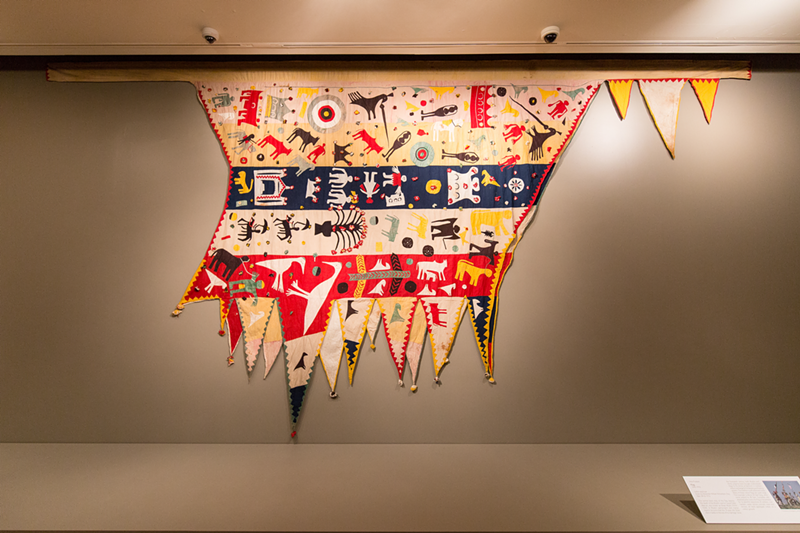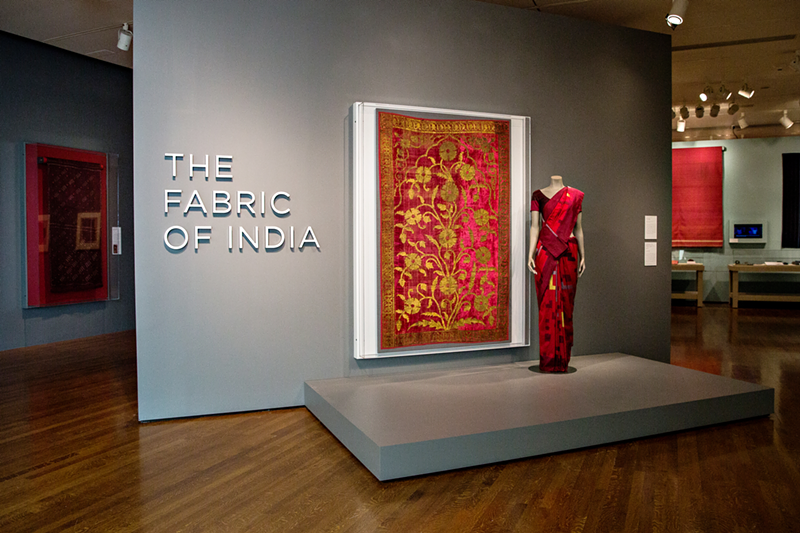Like the process of creating textiles itself, Cincinnati Art Museum’s The Fabric of India exhibition weaves intricate threads that tell the story of a country steeped in rich history, culture and tradition. And perhaps India’s tale is best recounted through the art of creating cloth, a symbol not only of the past, but also of modern possibilities.
In part, it was that narrative underscoring the sheer beauty of many Indian fabrics that inspired Cynthia Amnéus — the museum’s curator of fashion arts and textiles — to bring the exhibit, originally organized by the Victoria and Albert Museum in London, to Cincinnati.
“Indian textiles didn’t just exist in a little bubble of history, but there is a robust and very active fashion and textile industry happening today,” Amnéus says. “That (element) was really important to us.”
Despite their colorful, bold and strong impact on India (and, really, the world), the show is the first major exhibition focused specifically on handmade Indian fabrics. The Fabric of India’s run at Cincinnati Art Museum marks its debut in the United States.
Originally opened at Victoria and Albert in 2015, The Fabric of India was helmed by that museum’s senior curator Rosemary Crill. As she neared retirement, Crill felt it was time to unearth V&M’s collection of Indian textiles, most of which were inherited from England’s India Museum (established in the early 19th century by the British East India Company) when it was shuttered in 1879.
Amnéus estimates that 70 percent of what was originally on view at V&M is in the current exhibit in Cincinnati. Though the show in London was larger, the V&M formatted the current iteration of The Fabric of India to make its size more manageable for other museums to display. A few of the most ancient and fragile pieces from the V&M collection weren’t able to make the trip. Though some pieces in the first run of the show stretched back to the 8th century, the oldest you’ll see at the exhibit in Cincinnati are from the 15th century.
In Detail
On display in the Cincinnati Art Musem’s Western & Southern Galleries — the same space occupied by the highly-trafficked Terracotta Army exhibit earlier this year — The Fabric of India features over 170 handmade objects. It’s not organized chronologically, but thematically, with six distinct sections.
The pieces in the exhibit range in depth and detail. Amnéus claims that there’s so much to show that she can barely fit it all into an hour-long tour. As we walk through the space, she stops at nearly every piece and recounts its history.
The exhibit is filled with warm hues and intricate designs, depicted through everything from the border of a dress embroidered with the emerald green wings of jewel beetles to a hanging, or bithiya, that fills an entire room with red, green and gold. Created in the first half of the 20th century and likely used to decorate during a festival or wedding, the colorful bithiya was (remarkably) found on a New York City sidewalk in 1994.
One of Amnéus’ personal favorites of the show may appear on the surface to be more minimalist. Located near the front of the “Nature and Making” section, a piece of sheer, off-white muslin hangs. But look closer: the threads within are tightly and intricately spun.
“To spin it that fine by hand and to weave such fine fabric is amazing,” she says. “I mean, that speaks to me of the skill of these Indian artisans.”
She also points out a Kashmir map shawl that shows the city of Srinagar from an aerial view.
“You can look at it through the plexiglass and be amazed by it, but I was two inches from it when it came out of the crate and taking detailed pictures,” Amnéus says. “I couldn’t imagine making stitches that small to embroider something and it’s just a beautiful piece. You can look at it forever and discover new things.”
The tiniest of details populate the shaw’s cityscape. According to a catalog of the gallery edited by Crill, the map is oriented with the east side of Srinagar at the top. There, lush gardens unfold. Specifically, the Mughal gardens of Nishat Bagh and Shalimar Bagh. As depicted on the shawl, the gardens are near Dal Lake, where shikaras — lightweight, flat-bottomed boats — languidly float. In one spot, a man is even seen taking a dip. Houses crowd the shawl, as do temples and cross-shaped mosques. Soldiers ride on horseback. Labels of landmarks and districts are marked in Persian script.
Embroidered with goat hair, all of the shaw’s many subtle details take place within a space of 7.5 inches by 6.5 inches.
More Than Clothes
Even India’s flag — adopted in 1947 after the country declared independence from Britain — harkens back to its textile heritage. A blue 24-spoke wheel sits in the center, backdropped by white with strips of orange and green. By law, every flag is made with khadi cloth, a simple, handwoven fabric that carries connotations of defiance and freedom. Mahatma Gandhi, a leader of the Indian independence movement, pushed for its use.
In the 20th century, as explored in the exhibit’s section about the “Political Power of Textiles,” Gandhi believed swaraj (self-rule) could be made possible through economic self-reliance. “For him, khadi embodied moral, social, economic and political values,” reads the Fabric of India catalog.
He called for Indians to create and wear their own cloth, even holding mass spinning demonstrations. A video in the exhibit depicts Gandhi spinning cloth and wearing simple clothes, a purposeful move on his part because he wanted to relate to the masses, especially those in the lower class. Gandhi once said, “Foreign cloth must be totally banished from the Indian market, if India is to become an economically free nation, if her peasantry is to be freed from chronic pauperism… protection of her staple industry is her birthright.”
In the video, the leader looks up and waves at the camera while chatting with nearby citizens. Unlike the vivid colors that fill most of The Fabric of India, this section feels starkly minimal.
Post-independence, Jawaharlal Nehru (India’s first prime minister and a Gandhi follower himself) continued to use the influence of khadi cloth. But unlike Gandhi, Nehru believed that mass industrialization, as opposed to a handmade, village-led economy, was the key to furthering India’s development.
“But (Nehru) realized that there were a lot of artisans and makers that depended on that handwork to survive,” Amnéus says. “So he started to create these government organizations that supported, nurtured and continued those traditions.”
The movement as a whole is partially why traditional textile-making methods are still so important in the country.
“They’re not losing that,” she says. “Which happens with a lot of cultures — the generations die out and those techniques haven’t been passed down and die out.”
The Modern Age
To understand the full weight of The Fabric of India, one must first become acquainted with the methods used to create the items that populate the museum’s walls.
That’s where the exhibit begins — by asking, “How?” As a person who works in textiles, Amnéus says that most people don’t understand the process.
“So it’s a great opportunity,” she says, “but also it gives you a preface for all the things you’re going to see, and know how those things are made and the time-consuming handwork that went into that.”
When Amnéus visited India last November, she attended workshops where she saw these traditional techniques being done firsthand. But she says she also saw how people were “creating contemporary pieces that interest a more global audience,” instead of solely working within tradition.
Today, Amnéus notes that many Indians are taking those traditional techniques passed down for centuries and becoming designers, making their work marketable to a wider audience.
Perhaps this notion is most visible when guests arrive at the end of the Fabric of India exhibit and are greeted by a row of striking contemporary saris, the iconic draped women’s garment. According to the catalog, since the traditional sari has been in decline, designers have been creating a more modern look that caters to “a generation of affluent, cosmopolitan women.”
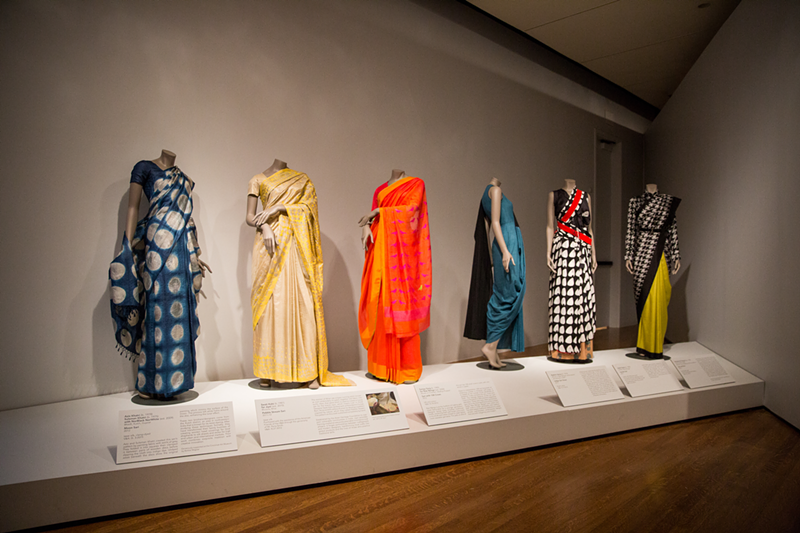
Take the exhibit’s “Moon Sari,” designed by Aziz and Suleman Khatri. Radiant white spheres bleed into dark blue on the fabric, which drapes over one shoulder and features elegant pleats. Another outfit in the exhibit is a jacket designed by Rajesh Pratap Singh. Awash in orange and denim blue, the fabric first appears floral, a callback to the classic blockprinted ajrakh process. But peer closer and skulls are revealed. It’s a striking mesh of tradition and new-age flair.
“In the exhibition, you see European designers who are respectfully using Indian artists and you see Indian artists who are either doing the work themselves or pulling other craftsmen and artisans to do that work,” Amnéus says. “So there’s a great connection there. It’s good to see those original techniques being used and introduced to new people.”
The Fabric of Storytelling
When piecing the entirety of The Fabric of India together, viewers see that cloth is just the medium through which expansive narratives are told. There is work layered in religious iconography, like the “Shrine Flag” splayed across a wall. More akin to folk art style, the edges are zig-zagged rather than a traditional geometric shape. In the center lies a bleeding body, over which another figure weeps. But they’re surrounded by chaos. Zoom out and you see that the piece depicts the story of an 11th-century Muslim warrior saint named Saiyyad Salar Mas’ud who, on the night before he was to be married, died in battle at 19 years old.
Other pieces tell the story of Eastern and Western cultures colliding, providing a backdrop for viewers to better understand the effects of orientalism and colonialism. For example, “Depicting Nations Hanging” (dated to 1640-50) shows men and boys donning Eastern dress, but their striking blue eyes reveal them to be Westerners. Below, women wear a mix of European and Indian styles. The placard beside the hanging notes that such themes would become more present in the coming century.
“We have this idea of what India and Indians are all about,” Amnéus explains. “They were (a) very sophisticated culture thousands and thousands of years ago, and their history is very long and the history of textiles is very long. When the Europeans came in the early 1600s, cotton was a new thing to them.”
But the Indians had been producing cotton long ago. Europeans also didn’t know the technical information about mordants that Indians did. And some of the techniques they used were so complex it took months to complete. Amnéus calls it a great story of sophistication that the exhibit is attempting to bring to the public.
“For me, one of the parts of the exhibition that is fascinating is this cross-cultural aesthetic exchange,” she says. “So, the Indians would use their traditional techniques, but if Armenian traders came in and said, ‘We want you to recreate this,’ or Europeans said, ‘Here’s a botanical illustration, can you make this?’ the Indians would tailor their exports to their clientele. They would always put their own spin on it.”
In short, they became masters at catering to the people who wanted a piece of their artistry.
Building Bridges
Through bringing the exhibit to Cincinnati, Amnéus feels the Cincinnati Art Museum was able to strengthen its relationship with the city’s Indian community. The museum was particularly pleased with the turnout for Oct. 26’s Art After Dark event, at which they celebrated Diwali, a Hindu festival of light marking the beginning of the fiscal year in India.
Jill Dunne, CAM’s Director of Marketing and Communications, says nearly 1,800 people attended the Diwali edition of the museum’s popular after-hours event.
“And it was one of the most diverse crowds we’ve ever had at Art After Dark — especially with the American-Indian community,” she adds. “We had people wearing saris. It was amazing. Amazing, amazing.”
The Fabric of India was partially made possible by an $11.75 million gift from Carl and Alice Bimel (Carl died in 2013; Alice in 2008) intended to bring in art from South Asia, Iran and Afghanistan. So when the news that the Victoria and Albert Museum was readying The Fabric of India for the road was brought to Amnéus’ desk, she saw it as an opportunity.
With the gift, the museum also hired a new curator of South Asian and Islamic art, Ainsley M. Cameron. Another exhibit currently on display across the hall from the Museum’s Terrace Café is Collecting Calligraphy: Arts of the Islamic World.
Going forward, as chief curator, Amnéus wants to make sure the CAM’s lineup is as diverse as possible.
“I just think it’s important; those are the people that come to the museum. And we want as diverse of a population as possible, so we want to offer them something that reflects their culture,” she says. “Not that only Indians are going to come to the show — we don’t want to have that relationship with our visitors — but we want our exhibits and collections to reflect a very diverse population.”
At the end of The Fabric of India, an overall narrative of India and its people and culture comes into focus. It’s one of resilience sparked in wide-ranging color and stitched with precise, careful hands. But it also is apparent that the story of a people bound to both tradition and contemporary wiles hasn’t ended, and perhaps never will.
The cloth lives on.
The Fabric of India runs through Jan. 6, 2019 at the Cincinnati Art Museum. More information on special exhibition prices can be found at cincinnatiartmuseum.org.

